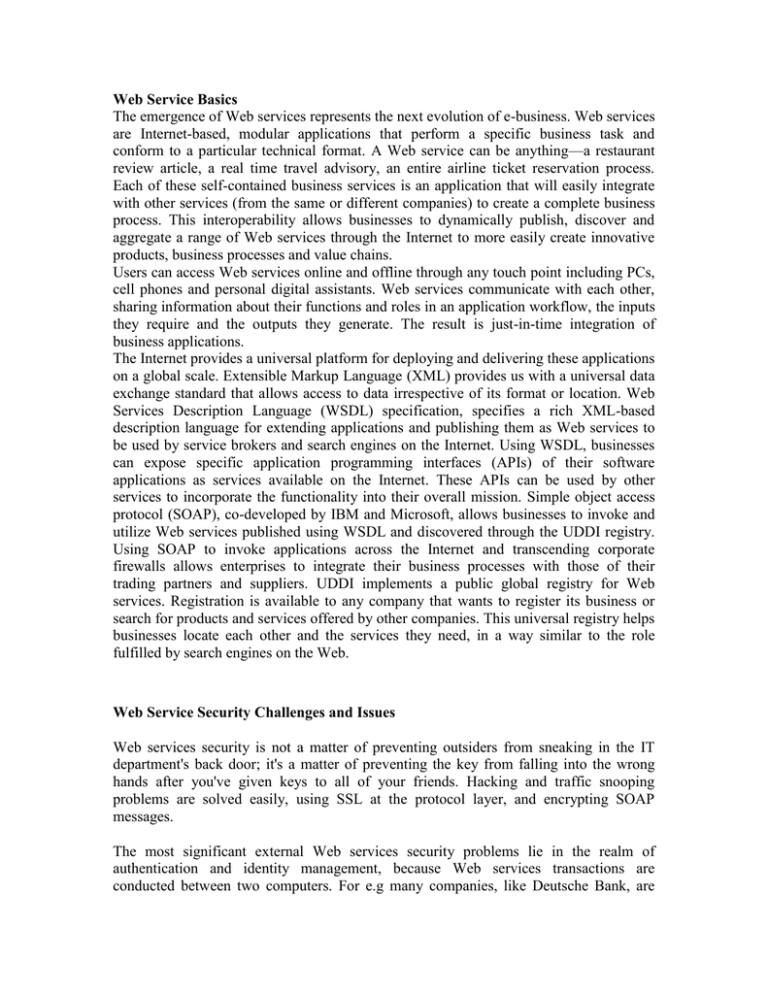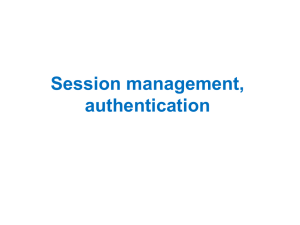Web Service Basics
advertisement

Web Service Basics The emergence of Web services represents the next evolution of e-business. Web services are Internet-based, modular applications that perform a specific business task and conform to a particular technical format. A Web service can be anything—a restaurant review article, a real time travel advisory, an entire airline ticket reservation process. Each of these self-contained business services is an application that will easily integrate with other services (from the same or different companies) to create a complete business process. This interoperability allows businesses to dynamically publish, discover and aggregate a range of Web services through the Internet to more easily create innovative products, business processes and value chains. Users can access Web services online and offline through any touch point including PCs, cell phones and personal digital assistants. Web services communicate with each other, sharing information about their functions and roles in an application workflow, the inputs they require and the outputs they generate. The result is just-in-time integration of business applications. The Internet provides a universal platform for deploying and delivering these applications on a global scale. Extensible Markup Language (XML) provides us with a universal data exchange standard that allows access to data irrespective of its format or location. Web Services Description Language (WSDL) specification, specifies a rich XML-based description language for extending applications and publishing them as Web services to be used by service brokers and search engines on the Internet. Using WSDL, businesses can expose specific application programming interfaces (APIs) of their software applications as services available on the Internet. These APIs can be used by other services to incorporate the functionality into their overall mission. Simple object access protocol (SOAP), co-developed by IBM and Microsoft, allows businesses to invoke and utilize Web services published using WSDL and discovered through the UDDI registry. Using SOAP to invoke applications across the Internet and transcending corporate firewalls allows enterprises to integrate their business processes with those of their trading partners and suppliers. UDDI implements a public global registry for Web services. Registration is available to any company that wants to register its business or search for products and services offered by other companies. This universal registry helps businesses locate each other and the services they need, in a way similar to the role fulfilled by search engines on the Web. Web Service Security Challenges and Issues Web services security is not a matter of preventing outsiders from sneaking in the IT department's back door; it's a matter of preventing the key from falling into the wrong hands after you've given keys to all of your friends. Hacking and traffic snooping problems are solved easily, using SSL at the protocol layer, and encrypting SOAP messages. The most significant external Web services security problems lie in the realm of authentication and identity management, because Web services transactions are conducted between two computers. For e.g many companies, like Deutsche Bank, are building portals that call on Web services to gather data from back-end applications. The problem is that those applications don't know where the request is coming from. Authentication is the process of making sure that the person who is asking to use the web service is really the person that they claim to be. This is done by requiring the user (also known as the "principal") to provide a set of credentials. In return, they will receive a security token that can be used to access the server. Since Web services are based on message exchanges on the net with the possibility of dynamic short term relationships, security is a major concern.. Most of the application internals are exposed to the outside world. As the application is closer to the data it opens room for security threats. Traditionally SSL, TLS, VPNs and IPSEC are some of the common ways of securing content. However these are point-to-point technologies. They create a tunnel through which data can pass. IPSEC can authenticate hosts on either side of the communication. With SMIME(secure multi-purpose Internat mail exchange) protocol, data could be sent digitally signed and encrypted over the internet. Both these protocols require that the communicating parties have persistent identities. However these protocols cannot be applied to authenticate participants of dynamically generated sessions.. Web Services require more granularity. They have to maintain secure content and control according to their security policies. Following is a set of challenges: Inter-enterprise Web services are dealing with untrusted clients End-to-end isn’t just point-to-point. The creator of the message wrote the payload but intermediaries may touch or rewrite the message afterwards. Clients and services do not have a way to negotiate their mutual constraints and capabilities before interacting. SSL along with TLS is used to provide transport level security for Web Service authentication. Between the web site and the web service there is a need for persistent message security for SOAP documents. SSL is inadequate for this type of security. While SSL encrypts the data stream, it doesn't support end-to-end confidentiality; it leaves the data exposed between the web site and the web service provider. SSL is Not Adequate for Securing Web Services SSL has several limitations when it comes to web services. The limitations can be summarized as follows SSL provides point-to-point security or operates between end-points (and not applications), but for web services we need end-to-end security in which multiple intermediate nodes could exist between the two end-points. In a web services environment, there could be multiple XML-based business documents going through multiple intermediary nodes and it will be difficult for such nodes to participate in security operations in an integrated fashion. SSL operates at the transport level and not at the message level. In other words, messages are protected only while in transit. That is, you cannot save the message for later to prove that it hasn't been modified. SSL provides confidentiality and sender/receiver authentication but doesn't support non-repudiation. Using SSL, a communicating partner cannot prove that the other party has performed a particular transaction. That is, SSl doesn't support an end-to-end audit trail from service request to service response. SSL doesn't support element-wise signing and encryption. Given a large XML order document, one may want to only sign or encrypt the credit card info...and that is difficult in SSL. This is because SSL is a transport-level security scheme as opposed to a message-level scheme.



